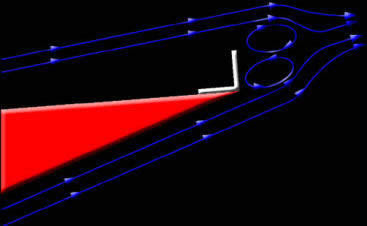First off, I am no aero expert (far from it).
After seeing RAAMaudio's build, and his custom undertray (integrated into the front splitter), I started to read about how to maximize the pressure differential between the front and back of the FMIC/Radiator.

Using the above design, you get a lot of negative pressure at the back of the engine bay, and that should help pull air through the FMIC etc.
It SEEMS that a vent (like a NACA duct) is a BAD IDEA, as it would actually ADD pressure in the engine bay.
(If it was positioned facing forward, narrow end towards the nose, wide end towards the back of the car)
My question is, is there any advantage in putting some kind of duct in the undertray, such that it create a vaccume as air passes under the undertray, and helps to pull higher pressure air out from the engine compartment? Seems like the above design would be just fine, but I'm curious.
Aside: I like the little wickerbill (Gurney flap) at the back of the undertray, but wouldn't that create LIFT?
Finally, thoughts on how best to add Front Wheel Deflectors? (or even needed?)
--- Max
After seeing RAAMaudio's build, and his custom undertray (integrated into the front splitter), I started to read about how to maximize the pressure differential between the front and back of the FMIC/Radiator.

Using the above design, you get a lot of negative pressure at the back of the engine bay, and that should help pull air through the FMIC etc.
It SEEMS that a vent (like a NACA duct) is a BAD IDEA, as it would actually ADD pressure in the engine bay.
(If it was positioned facing forward, narrow end towards the nose, wide end towards the back of the car)
My question is, is there any advantage in putting some kind of duct in the undertray, such that it create a vaccume as air passes under the undertray, and helps to pull higher pressure air out from the engine compartment? Seems like the above design would be just fine, but I'm curious.
Aside: I like the little wickerbill (Gurney flap) at the back of the undertray, but wouldn't that create LIFT?
Finally, thoughts on how best to add Front Wheel Deflectors? (or even needed?)
--- Max



